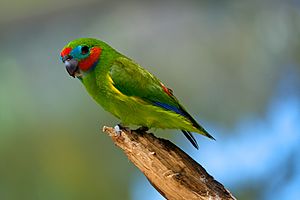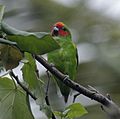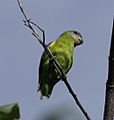Double-eyed fig parrot facts for kids
Quick facts for kids Double-eyed fig parrot |
|
|---|---|
 |
|
| Male C. d. macleayana at Birdworld Kuranda, Queensland, Australia | |
| Conservation status | |
| Scientific classification | |
| Genus: |
Cyclopsitta
|
| Species: |
diophthalma
|
The double-eyed fig parrot (Cyclopsitta diophthalma) is a tiny, colorful bird. It's also known by other names like the blue-faced fig parrot or dwarf fig parrot. This parrot mostly lives in the forests of New Guinea and nearby islands. You can also find small groups of them along the tropical coast of Australia.
It's the smallest parrot in Australia, only about 14 centimeters (5.5 inches) long! This parrot is mostly green with a very short tail. It has a big head and beak for its size, and cool red and blue marks on its face. It's called 'double-eyed' because of a blue spot near its eyes. This spot can look like another eye, especially on parrots from New Guinea.
Boy parrots often look a bit different from girl parrots. The males usually have more red on their faces, while females might have more silvery or blue colors.
Most double-eyed fig parrots are doing well in the wild. The IUCN says they are of "Least Concern". However, some types, called subspecies, are in danger. For example, Coxen's fig parrot (C. d. coxeni) is one of Australia's rarest birds. It's listed as "Endangered" because its forest homes have been cut down.
Contents
What Do Double-Eyed Fig Parrots Do?
Double-eyed fig parrots love to eat different things. They look for figs, berries, seeds, and sweet nectar. They also enjoy finding grubs (insect larvae) that live inside wood. These parrots usually search for food in pairs or in small groups.
They fly very fast and straight. When they fly, or sometimes when they are sitting on a branch, they make a short, high-pitched call. It sounds like zzzt-zzzt or zeet-zeet. This is different from the loud screeches many other parrots make. When they are busy eating, they might make softer, chattering noises.
Unlike many other parrots that use holes already made in trees, double-eyed fig parrots are special. They dig their own nests! They usually make their nest holes in rotten trees.
Types of Double-Eyed Fig Parrots
There are eight different types, or subspecies, of the double-eyed fig parrot. Three of these types live only in Australia. The other five live in New Guinea and the islands close by.
Here are some of the different types:
- C. d. aruensis (Aru double-eyed fig parrot)
- C. d. coccineifrons (Astrolabe Mountain fig parrot)
- C. d. coxeni (Coxen's fig parrot)
- C. d. diophthalma
- C. d. inseparabilis (Tagula fig parrot)
- C. d. macleayana (Macleay's fig parrot or red-browed fig parrot)
- C. d. marshalli (Marshall's fig parrot)
- C. d. virago (Hartert's double-eyed fig parrot)
Images for kids
-
Female C. d. marshalli from the Cape York Peninsula, Australia
-
Male C. d. macleayana in Daintree National Park, Queensland, Australia
-
Female C. d. macleayana in Cairns, Queensland, Australia
See also
 In Spanish: Lorito dobleojo para niños
In Spanish: Lorito dobleojo para niños






